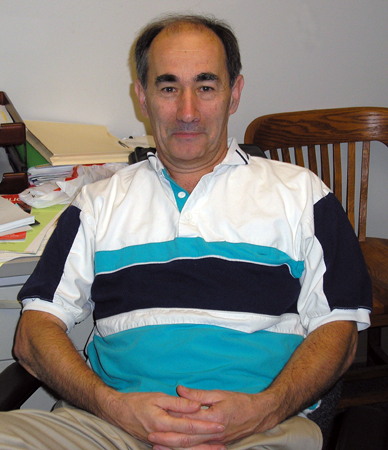Faculty Emeritus: Ronald Viola, Ph.D.

Emeritus and Distinguished University Professor
Email: ron.viola@utoledo.edu
Office: WO3216
Phone: (419) 530-1582
Fax: (419) 530-1583
Professional Background:
B.S., 1967, Fordham University;
M.S., 1973;
Ph.D., 1976, Pennsylvania State University;
NIH Postdoctoral Fellow, 1977-1979,
University of Wisconsin; Assistant Professor, 1979-1984,
Southern Illinois University-Edwardsville; Associate Professor, 1984-1989;
University of Akron; Professor, 1989-2000.
Research Synopsis:
Biochemistry:
Mechanistic studies of enzyme-catalyzed reactions; mapping of enzyme active site by chemical modification, structural and modeling studies, and site-directed mutagenesis; introduction of unnatural amino acids into proteins.
My research interests are in the general areas of the mechanism of action of enzymes and in the role of metal ions in biological systems. The ongoing projects in my research group range from classical enzyme mechanistic studies, through modern molecular and structural biology, to inorganic coordination chemistry.
A number of different enzyme systems are currently under active investigation. A coordinated study of the structure and activity of the enzyme aspartase is being conducted in my research group. Our studies have shown that the enzyme is highly specific and has a requirement for divalent metal ions under certain conditions. We have also discovered that this enzyme can be modified to a form that can take on a non-catalytic role as an activator of blood clot dissolution. We have solved the high resolution structure of this enzyme and these studies, carried out in conjunction with site-directed mutagenesis studies, have enhanced our understanding of the elements of structure that are the foundation of enzyme biological activity.
The enzyme aspartokinase occupies a key branch point in amino acid biosynthesis, serving as a commitment to the synthesis of four essential amino acids. This enzyme is bifunctional, with two different activities catalyzed at two distinct active sites. We have recent cleaved the gene that encodes for this enzyme, and have separately expressed each catalytic domain. Several additional enzymes in this pathway are also being investigated as potential targets for drug or herbicide development, including aspartate semialdehyde dehydrogenase, and homoserine kinase. Site-directed mutagenesis studies on these enzymes have led to the identification of critical functional groups that are involved in substrate recognition and catalysis. Our newly determined high resolution structure of the dehydrogenase has confirmed our earlier functional groups assignments, and has suggested a number of intriguing mechanistic possibilities that are awaiting investigation.
Our research group is also developing a new approach to study enzyme mechanisms that will allow the specific replacement of many amino acids in a protein with a wide range of structurally altered amino acid analogs. This method complements the specificity of site directed mutagenesis with the diversity of chemical modification, and overcomes the shortcomings of each approach. Our preliminary results have led to the introduction of a new proton shuttle group in carbonic anhydrase, and the conversion of malate dehydrogenase into a phenyllactate dehydrogenase. We have also built a new metal ion binding site, into an enzyme that did not previously require a metal ion, in an attempt to create a new catalytic activity. The production of these "designer" enzymes will expand the range of chemical reactions that can be accelerated by these biocatalysts.


